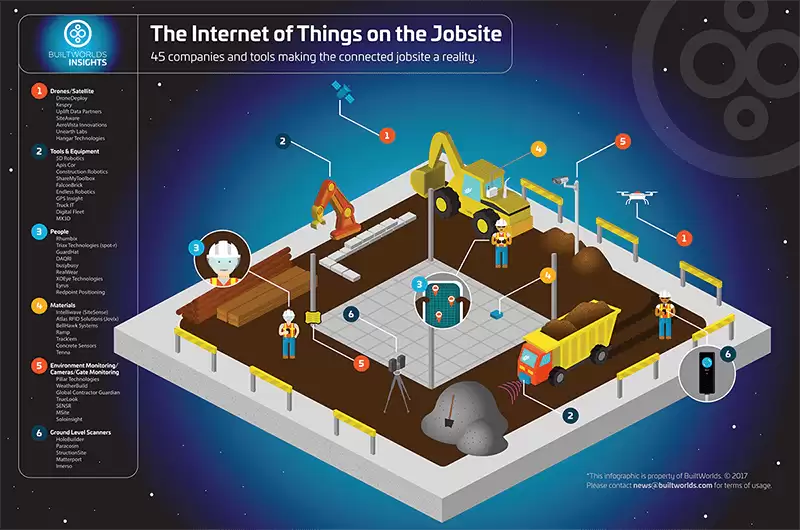Weather is an important factor in planning, designing and implementing a construction project.
It has diverse and wide impacts on the outcome of the project.
From the initial stage to post-project documentation, weather affects the construction site, worker safety,
Planning, scheduling, and performing equipment, running activities.
Moreover, severe weather conditions in certain areas can make it difficult for construction activities to progress.
A severe weather event can cost an organization up to $400,000 in a single day of lost work on a $400 million project.
But using artificial intelligence, big data, deep learning, machine learning,
And predictive models, construction personnel and project activities can be protected from the impact of weather.
Stakeholders cannot control the weather,
but they can take responsibility for its effects, including opportunities and threats.
Adam Ammanski, CEO of WeatherBuild, believes that project managers choose WeatherBuild,
to decide on the impact of changing weather on their project and has become a powerful tool for risk management strategies in today’s environment.
WeatherBuild is one solution to weather related problems.
The software provides comprehensive solutions for forecasting the weather and how the weather will affect the project.
This software can handle all the weather-related challenges that may haunt a construction project.

1. Use WeatherBuild to prepare for extreme weather events
To plan construction work, the previous practice for project managers was to rely on general weather forecasts and level points recorded for a large geographic area.
However, these types of data are no longer reliable,
especially in large and complex projects in remote areas where a weather forecast application is unreliable.
All essential weather information can be accessed quickly using big data.
An AI-powered program such as WeatherBuild can integrate weather information from certified quality-controlled and business-grade sources with project plans and scheduling information.
After obtaining all the information, a site-specific simulation can be created to provide the required solution for a specific activity of the project.
Using a proprietary rules engine,
WeatherBuild takes complex data from various sources and processes it in a way that is practical and easy for project managers to understand.
Essentially, WeatherBuild provides accurate inference regarding explicit weather events for the project,
safety risks, and schedule impacts in a format that makes it easier for groups and crews to make quick decisions to stay cost-effective despite unpredictable weather.
The impact on each project activity is associated with weather events and the outcome is described in terms of the impact on the activity schedule and the impact on worker safety.
WeatherBuild also provides resource suggestions for heavy machinery,
construction materials, work results, and environmental controls.

How WeatherBuild works
Let us understand the work of WeatherBuild by taking an example of construction work which is carried out by crane.
WeatherBuild relates lift exercises to both predicted events and the ongoing ground reality of wind speed,
wind direction, wind gust, and wind gusts at various heights above ground level.
After the data is correlated, WeatherBuild analyzes the tabular data provided by the customer,
such as crane type, and safety hazards for crane lifting exercises.
Also, alternative options are provided in the output report, for example,
whether the lift should be performed with a reduced lifting capacity or the maximum lift height should be reduced.
All of these features come in the automatically generated scheduled reports for each shift.
For example, for work that starts at 7 AM, reports will be generated automatically by 6 AM as well,
All alerts about weather events affecting schedules and safety are sent via an instant message,
with a short, mobile-friendly link.
There is no online interface to sign in, and no app to launch.

2. Report and alerts generated by WeatherBuild
Adam Ammansky demonstrated through an example how a client for a high-rise construction project required more than 100 custom weather rules that were clear to heavy machinery and building materials.
For example, if the wind speed or the wind at different altitudes exceeds preset limits,
The client will know what safety measures to take before such a wind event, and how temporary scaffolding and staging may be affected,
And what test do they have to do after the event to ensure the scaffolding platform is safe to work on.
WeatherBuild sends notifications about rainstorms, lightning strikes, and changes in weather.
It can also detect the locations of lightning strikes in real time.
The administrator, equipment operator and security supervisor receive warning notifications on their mobile phones within a minute after the lighting strikes.
For each task, location, and resource, the customer can set up to three ranges of warnings,
clocks, and warnings.
After that, WeatherBuild only sends one alert within one hour for every three bands when the first lightning strikes.
The main reason to notice one is that lightning strike can occur continuously in milliseconds or in seconds,
The WeatherBuild team prefers not to spam the safety manager with too many instant messages.
When lightning is not recognized within the peripheral range of a particular area,
WeatherBuild sends a countdown timer notification to help crew and workers know when they can safely resume work.
After the lightning bolt has passed, customers have a set of records that show each lightning strike with the date, time, and geolocation stamp.
The stamp represents each 10-mile-second location and time for all lightning strikes.
The project manager can take this record to the project owner as confirmation that they cannot work and request an extension on time or request relief funds in case of damage.
For more architectural news


 العربية
العربية